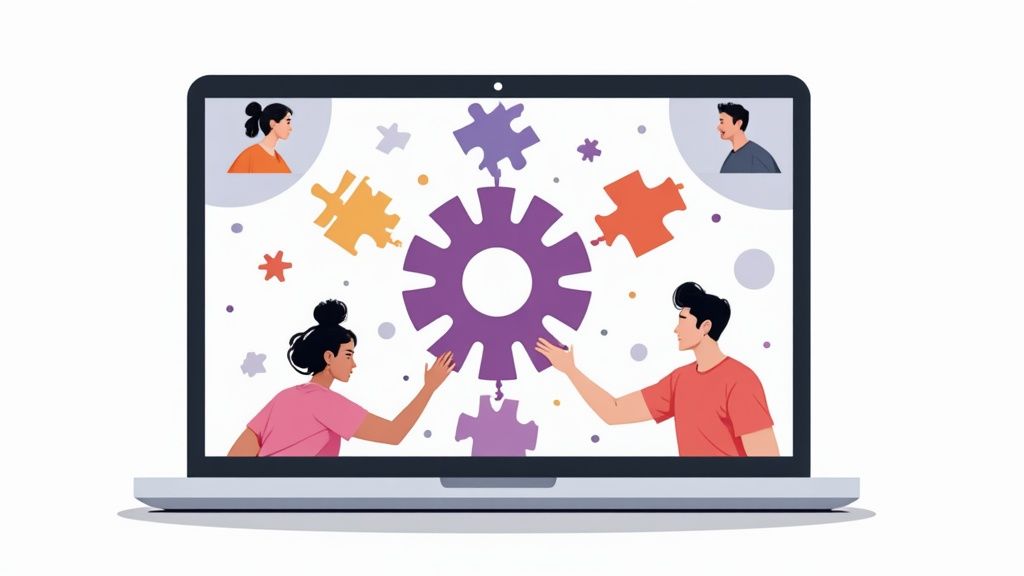
In a world where remote work is a permanent feature of business, fostering a connected and motivated team is paramount. The old playbook of virtual happy hours and generic check-ins is no longer sufficient. Employees crave genuine connection, meaningful recognition, and a sense of belonging, regardless of their physical location. As we look to redefine remote connection in 2025, it is important to understand the current landscape of remote work and the evolving dynamics between office and home-based setups.
This article dives deep into actionable remote employee engagement ideas that go beyond the surface, offering fresh, practical strategies to cultivate a thriving company culture. We'll explore innovative approaches that address the core needs of a distributed workforce, from fostering psychological safety to promoting holistic well-being.
Whether you're a tech startup, a creative agency, or a large enterprise, these insights will equip you to build an environment where every employee feels valued, engaged, and empowered to do their best work. We will move past obvious advice and provide specific, implementable tactics for everything from digital recognition platforms to structured one-on-one feedback sessions, ensuring you have the tools to build a cohesive, high-performing organization.
One of the most significant challenges in a remote setup is replicating the spontaneous, camaraderie-building interactions that happen naturally in an office. Virtual coffee chats and informal meetups are powerful remote employee engagement ideas designed to fill this void. These are short, structured yet casual video calls focused on fostering personal connections rather than discussing work projects.
By creating dedicated time for non-work conversations, you help combat isolation and build the social capital that is crucial for effective collaboration and a positive company culture. These sessions mimic the "water cooler" moments that forge stronger, more resilient teams.

Implementing this strategy is straightforward with the right tools and approach. Many companies have found great success using automated platforms or simple scheduling. For example, GitLab uses the Donut app in Slack, which automatically pairs team members for virtual coffee, removing any organizational burden from managers. Similarly, Buffer's long-standing "pair calls" randomly connect two colleagues for a casual chat each week.
For a low-tech option, you can create dedicated Slack or Teams channels, like a "Virtual Water Cooler," where employees can share hobbies, photos, or interesting articles. This asynchronous format allows for ongoing, low-pressure interaction.
To ensure these sessions are effective and not just another meeting on the calendar:
In a remote environment, where employees' hard work can often go unseen, making appreciation visible is a powerful driver of engagement. Digital recognition and rewards platforms are technology-driven systems designed to systematize and amplify employee appreciation. They facilitate peer-to-peer praise, manager acknowledgments, and company-wide celebrations of achievements tied directly to core values.
These platforms are essential remote employee engagement ideas because they create a public and permanent record of positive contributions. By providing a structured way to say "thank you," they combat feelings of being undervalued and foster a culture where excellence is consistently seen and celebrated, boosting morale and motivation.

Adopting a recognition platform can be a seamless process with a clear strategy. Many top companies integrate these tools directly into their daily workflows. For example, companies like ZoomInfo and SurveyMonkey use Bonusly, which integrates with Slack and allows employees to give small, frequent bonuses tied to company values. Similarly, Microsoft Teams includes a built-in "Praise" feature for instant peer recognition within existing channels.
For a simpler approach, you can leverage dedicated Slack bots like HeyTaco, where team members can give each other virtual tacos as a fun, low-stakes form of acknowledgment. The goal is to make recognition easy, immediate, and a natural part of the team's communication habits.
To maximize the impact of your recognition program and ensure it feels authentic:
Moving beyond simple chats, structured virtual team-building activities and games are one of the most effective remote employee engagement ideas for fostering collaboration and morale. These organized events create shared positive experiences, break down formal hierarchies, and allow colleagues to interact in a low-stakes, creative environment. This is crucial for building the trust and psychological safety needed for high-performing remote teams.
These activities transform passive video calls into active, memorable interactions. By engaging in challenges that require teamwork and communication, employees develop stronger working relationships, which translates directly into smoother project collaboration and a more connected company culture.

Companies can leverage a host of platforms and services to organize these events. For example, Zapier uses virtual escape rooms from platforms like The Escape Game to challenge their team's problem-solving skills. Similarly, Google hosts online trivia competitions and game tournaments, while Airbnb famously offered virtual cooking classes with professional chefs as a way for teams to bond over a shared, hands-on activity.
For a simpler approach, companies like HubSpot encourage "Show and Tell" sessions where employees share a personal hobby or item. You can also organize virtual movie nights using browser extensions that synchronize video playback for all participants, creating a shared viewing experience.
To maximize participation and ensure your virtual events are a hit:
Trusting employees with their time is one of the most powerful remote employee engagement ideas. Flexible work schedules and autonomy move beyond the traditional 9-to-5 model, empowering individuals to decide when, where, and how they work best. This approach focuses on outcomes and results rather than hours clocked, showing employees they are valued for their contributions, not their presence.
When implemented correctly, this level of trust boosts morale, reduces burnout, and significantly increases job satisfaction and loyalty. It allows team members to integrate their professional and personal lives seamlessly, leading to a healthier, more motivated workforce.

Leading remote companies have successfully adopted this model. GitLab operates on a foundation of asynchronous communication, where detailed documentation allows work to progress across time zones without requiring real-time meetings. Similarly, Buffer champions a fully flexible schedule with no core hours, allowing employees complete control over their workday.
A well-known historical example is Best Buy's original Results-Only Work Environment (ROWE), which pioneered the concept that performance should be measured purely by output. These models require robust project management tools like Asana or Trello to maintain clarity on tasks and deadlines, ensuring everyone remains aligned despite varied schedules.
To successfully transition to a more autonomous work model:
Investing in professional development is one of the most impactful remote employee engagement ideas because it shows a clear commitment to an individual's long-term career path, not just their current role. Providing access to skill development, career advancement, and educational resources helps remote workers feel valued and connected to the company's future. It directly counters feelings of stagnation that can arise from working in isolation.
By fostering a culture of continuous learning, companies empower their teams to stay competitive and motivated. This demonstrates a mutual investment, where the growth of the employee directly contributes to the growth of the organization, strengthening loyalty and engagement.
Implementing a robust learning program remotely is highly achievable with modern digital platforms. Many leading companies have institutionalized these opportunities. For example, Amazon’s Career Choice program funds 95% of tuition for employees pursuing in-demand fields. Similarly, Google’s "g2g" (Googler-to-Googler) network enables peer-to-peer learning, a fantastic model for remote teams.
You can start by integrating platforms like LinkedIn Learning or Coursera for Business, offering a vast library of courses. Another approach is offering a dedicated learning stipend that employees can use for conferences, certifications, or workshops of their choice, giving them autonomy over their growth. For a deeper dive into current educational trends, you can explore more about skill development in growing markets.
To ensure your learning initiatives translate into real engagement and skill acquisition:
In a remote environment, the informal feedback and guidance that managers provide in person can easily get lost. Regular one-on-one check-ins are structured, recurring meetings between a manager and a direct report, making them one of the most vital remote employee engagement ideas. These sessions shift the focus from simple project updates to holistic conversations about career growth, challenges, and well-being.
This dedicated time ensures employees feel seen, heard, and valued as individuals, not just as contributors to a task list. By proactively addressing concerns and aligning on goals, managers build trust and psychological safety, which are foundational to a thriving remote team.
Leading tech companies have systemized one-on-ones to ensure they are a core part of their management culture. For instance, Google's managers are trained to hold weekly 1:1s that balance tactical updates with developmental coaching. Similarly, platforms like 15Five facilitate structured weekly check-ins where employees can share progress, challenges, and morale scores, creating a consistent feedback loop.
You can start by simply scheduling a recurring 30-minute meeting in the calendar every week or bi-weekly. Create a shared document where both the manager and employee can add agenda items beforehand, ensuring the conversation is productive and employee-driven.
To transform these meetings from a status report into a powerful engagement tool:
In a remote environment, it is easy for employees to feel disconnected from the company’s broader mission and vision. Virtual all-hands meetings and regular company updates are crucial remote employee engagement ideas that anchor everyone to shared goals and reinforce a sense of collective identity. These scheduled, company-wide gatherings are more than just presentations; they are vital forums for aligning teams, celebrating wins, and fostering transparency.
By bringing the entire organization together, you create a powerful sense of unity and shared purpose. These meetings ensure every team member, regardless of their location, feels like an integral part of the company's journey and understands how their individual contributions impact the bigger picture.
Successful implementation requires thoughtful planning to keep the sessions engaging and informative. Companies like Shopify host dynamic monthly 'All Hands' using interactive polls and live Q&A to drive participation. Buffer sets a high bar for transparency by sharing detailed revenue and performance metrics in its quarterly reviews, making everyone feel like a trusted stakeholder.
Similarly, GitLab holds 'CEO Coffee Chat' sessions with smaller, rotating groups of employees to foster direct communication with leadership. This approach makes large-scale meetings feel more personal and accessible. The key is to create a predictable rhythm and a format that prioritizes interaction over passive listening.
To ensure your virtual all-hands meetings are impactful and not just another video call:
Prioritizing employee wellbeing is a critical component of any sustainable business strategy, and for remote teams, it requires a deliberate and digital-first approach. Digital wellness programs are comprehensive initiatives focused on supporting the mental, physical, and emotional health of employees who work outside a traditional office. These are powerful remote employee engagement ideas because they show a deep commitment to employee welfare beyond work tasks.
These programs directly address the unique stressors of remote work, such as isolation, blurred work-life boundaries, and digital fatigue. By providing accessible resources, you help prevent burnout, improve focus, and cultivate a culture where employees feel genuinely cared for and supported.
Leading companies have successfully integrated wellness into their remote culture. For example, Salesforce champions its "Ohana" culture with dedicated mental health days and easily accessible resources. Microsoft offers its employees a subscription to Headspace for mindfulness, while Buffer provides a specific stipend that can be used for therapy sessions or wellness app subscriptions.
A great starting point is to offer subscriptions to platforms like Calm or Headspace for Business. You can also organize virtual fitness challenges, host webinars on stress management, or provide stipends for home office ergonomic setups. The goal is to offer a suite of options that cater to diverse needs and preferences, making wellness an accessible part of the daily work routine.
To build a wellness program that truly makes an impact:
Transparency in a remote environment is not just about communication; it’s about making progress visible and connecting individual contributions to collective success. Collaborative project management and goal tracking systems are fantastic remote employee engagement ideas because they create a shared sense of purpose and momentum. These platforms centralize tasks, progress, and objectives, ensuring every team member understands their role and sees the impact of their work.
When employees can clearly see how their tasks contribute to larger company goals, it fosters a powerful sense of ownership and motivation. This visibility eliminates ambiguity and builds trust, as everyone is aligned on priorities and progress. It transforms work from a series of isolated tasks into a collaborative journey toward shared achievements.
Adopting a unified platform is key to creating this transparent work environment. For example, companies like Google and Intel have famously used the OKR (Objectives and Key Results) framework to align their entire organizations. Modern tools like Asana, Monday.com, and Notion have built-in features that make implementing such frameworks seamless for distributed teams.
These platforms allow you to create visual project roadmaps, assign tasks, set deadlines, and track progress with real-time dashboards. By integrating goal-setting directly into the daily workflow, you make it an active, engaging part of the work process rather than a static document reviewed quarterly. You can explore a variety of these tools to find the right fit for your team. Find out more about the different remote collaboration tools on lathire.com.
To make your system a driver of engagement instead of just another administrative tool:
| Item | Implementation Complexity | Resource Requirements | Expected Outcomes | Ideal Use Cases | Key Advantages |
|---|---|---|---|---|---|
| Virtual Coffee Chats and Informal Meetups | Low | Minimal (video tools, scheduling) | Builds personal connections, reduces isolation | Small teams, remote employees needing informal bonding | Low cost, flexible scheduling, improves communication |
| Digital Recognition and Rewards Platforms | Medium | Software platform, management time | Increases motivation, strengthens culture | Large remote organizations, recognition-focused | Visible achievements, scalable, data insights |
| Virtual Team Building Activities and Games | Medium to High | Facilitation, activity costs | Enhances bonding, communication, fun | Teams needing engagement and collaboration boost | Shared experiences, customizable, stress relief |
| Flexible Work Schedules and Autonomy | Medium | Policy changes, training | Improves work-life balance, productivity | Organizations valuing autonomy and results | Attracts talent, reduces burnout, adaptable |
| Professional Development and Learning Opportunities | Medium to High | Financial investment, time allocation | Increases engagement, capability building | Career growth focused companies | Skill enhancement, retention, innovation |
| Regular One-on-One Check-ins and Feedback Sessions | Low to Medium | Manager time investment | Builds trust, improves engagement | Manager-led teams, individual development | Strong relationships, early issue detection |
| Virtual All-Hands Meetings and Company Updates | Medium | Video conferencing infrastructure | Maintains alignment, transparency | Entire organizations needing connection | Unity, leadership communication, employee recognition |
| Digital Wellness Programs and Mental Health Support | Medium to High | Program costs, privacy management | Reduces burnout, improves wellbeing | Companies prioritizing holistic employee care | Burnout reduction, productivity, talent retention |
| Collaborative Project Management and Goal Tracking | Medium | Software tools, training | Increases transparency, accountability | Remote teams needing coordination and tracking | Visibility, data-driven management, reduces micromanagement |
The journey to a vibrant, engaged remote workforce isn't about finding a single magic bullet. As we've explored, from virtual coffee chats to robust professional development programs, the solution is a mosaic of intentional, consistent actions. The collection of remote employee engagement ideas presented in this article serves as a foundational toolkit, offering a variety of levers you can pull to foster connection, boost morale, and drive performance within your distributed team. The true power lies not in implementing every single idea, but in thoughtfully selecting, customizing, and combining the strategies that resonate most with your company’s unique culture, values, and the specific needs of your employees.
True engagement is a dynamic, evolving process, not a static checklist. It requires a commitment to continuous improvement and a willingness to listen and adapt. To move from inspiration to implementation, consider these immediate next steps:
Mastering remote engagement is more than just a "nice-to-have" in today's global talent market; it is a profound competitive advantage. A deeply engaged team is more innovative, resilient, and productive. It translates directly to lower attrition rates, saving you the immense costs associated with recruiting, hiring, and training new talent. Furthermore, a strong remote culture acts as a magnet for top professionals worldwide who are actively seeking employers that prioritize employee well-being and a connected, supportive environment.
For organizations that operate with global teams, this cultural foundation is even more critical. To truly build a lasting remote culture, especially in diverse global teams, it's crucial to understand how to foster effective intercultural communication to bridge potential divides and build genuine rapport.
Ultimately, the effort you invest in your people is an investment in the long-term health and success of your business. By moving beyond ad-hoc perks and building a systematic framework for connection and support, you are not just managing a remote team; you are cultivating a thriving digital community poised for sustained growth and success. The work starts now.
